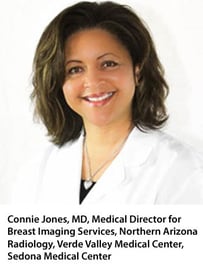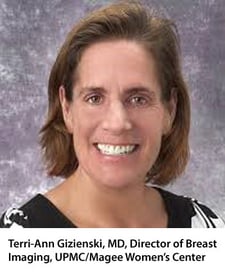
Keeping up with the advancements in the world of mammography affects radiologists, directors, supervisors and technologists alike. With the added pressure of detecting cancers at the earliest possible stage, staying on top of technology changes means changes to equipment, software upgrades and new processes.
There are inherent learning curves that need to be adapted to and navigating any kind of transition has its own set of challenges. As a result, standardized communication is more essential than ever.
Radiologists Speak Out About Skin Markers
We spoke with three dedicated breast imaging radiologists about their skin marking protocols as mammography technology continues to evolve - Connie Jones, Medical Director for Breast Imaging Services, Northern Arizona Radiology, Verde Valley Medical Center, and Sedona Medical Center; Terri-Ann Gizienski, Director of Breast Imaging,UPMC/Magee Women’s Hospital of Cranberry; and Christina Jacobs, Director of Breast Imaging, Bronson Healthcare.
 According to Dr. Jones, breast radiologists are becoming increasingly more clinical in respect to patient’s symptoms. As a result, it is even more important than ever for there to be a clear distinguishing protocol for communicating many different types of symptoms such as palpable lumps, focal pain, or regional thickening.
According to Dr. Jones, breast radiologists are becoming increasingly more clinical in respect to patient’s symptoms. As a result, it is even more important than ever for there to be a clear distinguishing protocol for communicating many different types of symptoms such as palpable lumps, focal pain, or regional thickening.
"In my practice, we view ourselves as a consult specialty for breast symptoms, not just interpreters of images. While the imaging is the most significant aspect of our value, there is much more involved in assessing patients. The referring physicians also appreciate the opinions and recommendations of the breast specialist."
Architectural distortion seen in DBT necessitated update in skin marking protocol
Dr. Jones went on to add that with greater use of digital breast tomosynthesis (DBT or 3D mammography), radiologists are now seeing even subtle distortion for remote benign surgeries that may appear as new. As a result, it is more difficult for radiologists to immediately and quickly assess images showing architectural distortion in patients with a history of breast surgeries.
This prompted her to update the skin marking protocol in her facilities accordingly to include using scar markers on every post-surgical patient, regardless of how long ago the surgery was.
Technologist education and buy-in is key to successful implementation
When it comes to educating staff and implementing the protocol, Dr. Jones shared that she finds it helpful to have a short, written handout as a reference guide for her technologists.
However, she added that the most important part of the process is meeting and discussing the protocol change with her technologists so that they understand the reasoning behind the change. This personal interaction goes a long way in encouraging compliance with the new protocol.
As Dr. Jones put it, “As clinical professionals, they are doing it because they understand the importance behind the protocol, not just because they are being told to.”
Impact and influence of ACR practice parameter recommendations
In fact, the American College of Radiology (ACR), also recently amended their Practice Parameters for the Performance of Screening and Diagnostic Mammography with a recommendation that “facilities should require consistent use of radiographically distinct markers to indicate palpable areas of concern, skin lesions, and surgical scars.”
Dr. Jones shared her views on this recent change. “The ACR significantly impacts me as a radiologist because it is an organization with high clinical and scientific standards that works for the advancement of radiology. I consider their recommendations in every aspect of my practice and strive as they do, to provide the highest level of service to our patients.”
 Dr. Gizienski also spoke about her experience with implementing new protocols, adapting to new mandates, and making sure her team understands the reasons for the changes.
Dr. Gizienski also spoke about her experience with implementing new protocols, adapting to new mandates, and making sure her team understands the reasons for the changes.
“If a new policy is needed, it often comes out of an issue that arises addressing the need for a change. For us, the process to modify our current protocol would entail the following steps: Write up a new protocol, submit proposed protocol to management to approve, disperse to the technologists, doctors and supervisors, then put it into a master policy procedures manual.”
The case for universal industry standardization
When it came to her skin marking protocol, Dr. Gizienski aligns with the ACR new recommendations, saying, “From my perspective, the goal would be for universal industry consistency. As a radiologist, this would minimize the chances of error as I am not guessing about each facility’s protocol based on where I am reading that day. That is how mistakes are made - when there is room for interpretation without standardization.
“Having a skin marking protocol for mammography that is followed consistently by all technologists and radiologists at various locations within a healthcare system helps to save time, increase communication and allow for fewer misinterpretations.”
Dr. Jacobs shared that what is most important to her when establishing new standard protocols in the breast center are first and foremost, patient safety, followed by ease of implementation.
A champion of using a consistent 5-shape skin marking system to improve communication between the technical staff and radiologists, Dr. Jacobs says the chance of misinterpretation is decreased and her workflow is more efficient.
Saves time, improves communication, better for the patient
 “When reading an exam, if I have the comparison from last year and I see a triangle marker on the image, I immediately know that the patient had a palpable concern last year or if there is a circle marker I know the associated density is a skin lesion. I know this without having to search through the patient’s previous paperwork. It becomes less of a fishing expedition. Ultimately, this translates to a savings in time spent reading, a decrease in recalls, improved communication and it is just overall safer for the patient. We want to avoid calling back patients unnecessarily for skin lesions and scars.”
“When reading an exam, if I have the comparison from last year and I see a triangle marker on the image, I immediately know that the patient had a palpable concern last year or if there is a circle marker I know the associated density is a skin lesion. I know this without having to search through the patient’s previous paperwork. It becomes less of a fishing expedition. Ultimately, this translates to a savings in time spent reading, a decrease in recalls, improved communication and it is just overall safer for the patient. We want to avoid calling back patients unnecessarily for skin lesions and scars.”
Dr. Jacobs also referenced the ACR and the impact its recommendations have on their practice; “We use it to guide us in the standards we use every day. It's also helpful when we go to hospital administration to implement protocols or discuss how things should be done. When we have their backing, it provides a lot of weight to those discussions.”
Like Dr. Jones and Dr. Gizienski, Dr. Jacobs’ facilities also have a written protocol regarding the use of skin markers that is communicated to all the technical staff and reinforced on a regular basis.
As she explained, “We've acquired a few smaller hospitals and have gone through those transitions where we have staff that may have followed different protocols in the past. We’re fortunate to have a small dedicated group of Breast Radiologists and we have a single lead mammography technologist who oversees the technologists at all sites, so we remain consistent in communicating and educating staff on consistent protocols.”
Each physician agreed that standardized processes helps make their job easier, increases communication, and ultimately benefits the patient.
To learn more about the Beekley Skin Marking System® for mammography, and the resources available to help you educate your staff on the importance of standardized communication with skin markers when it comes to efficacy and patient care, contact your Beekley Medical Account Manager at 1-800-233-5539 or info@beekley.com

Kathy Kaschuluk
Product Manager
